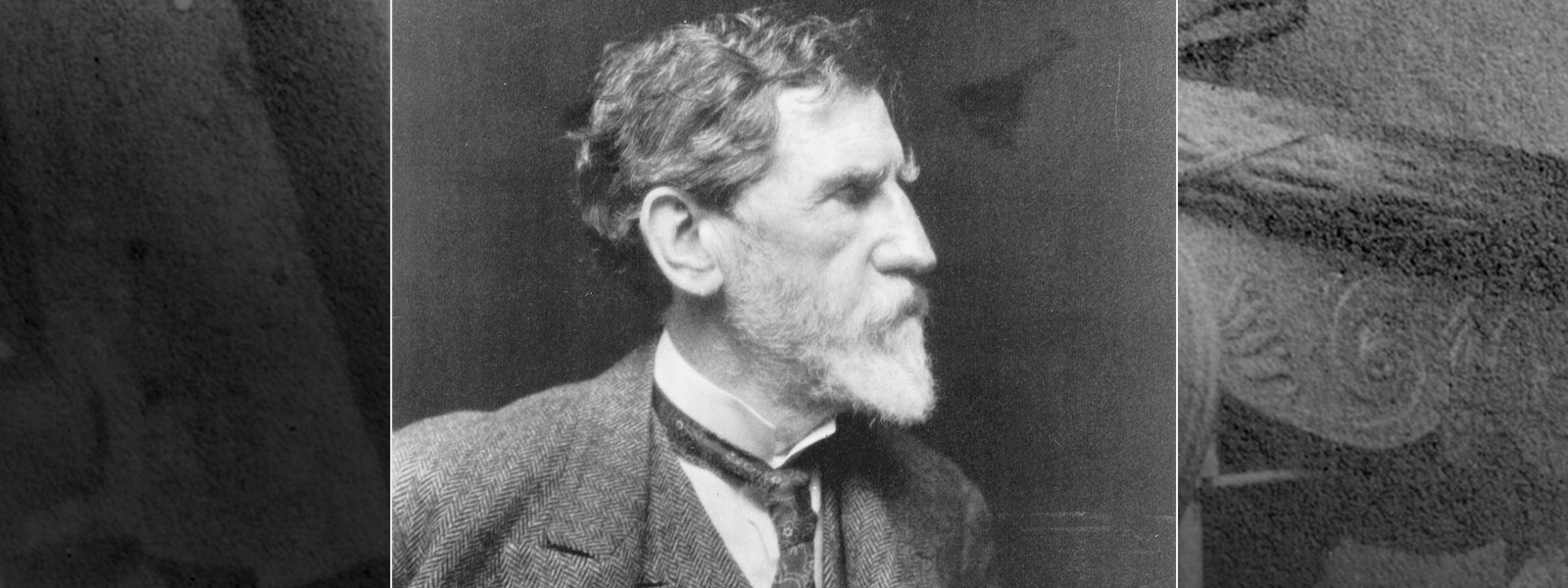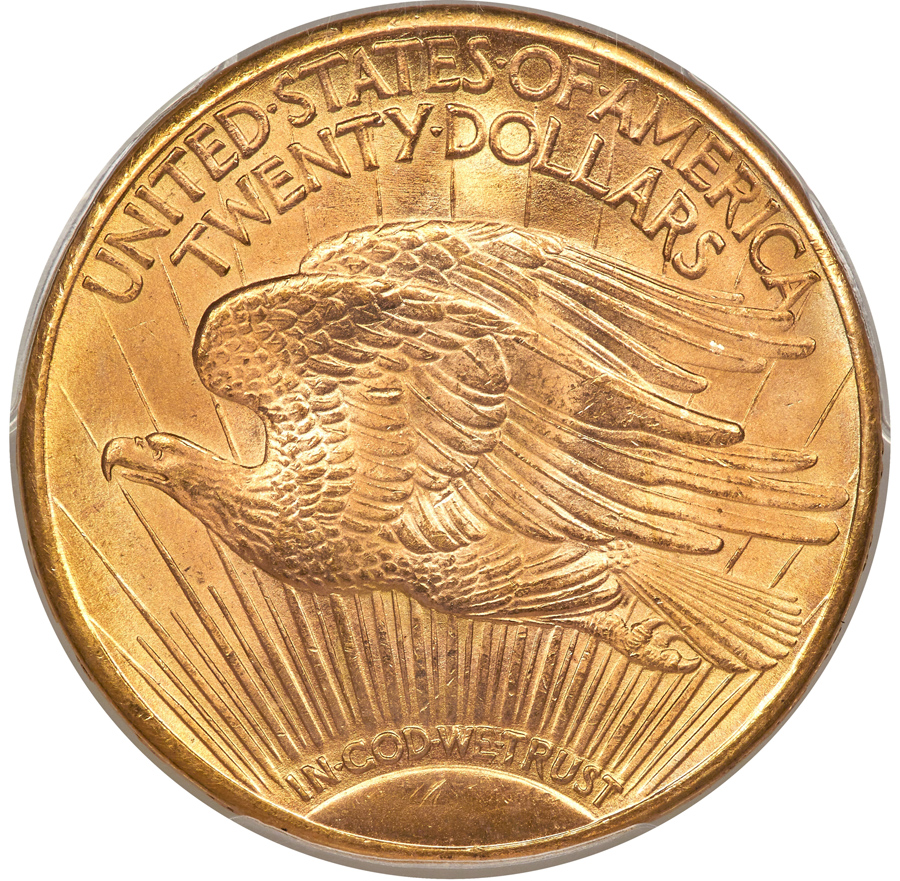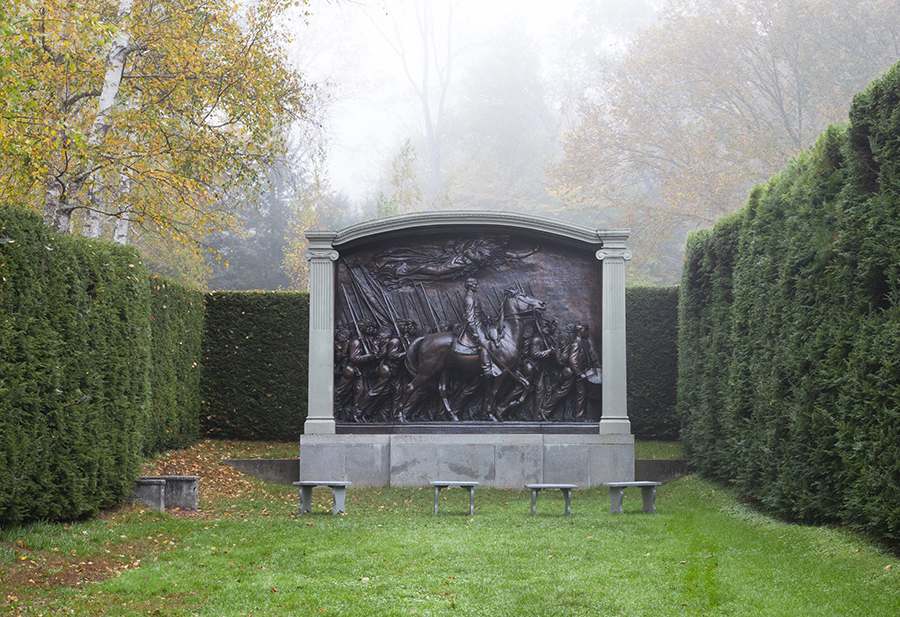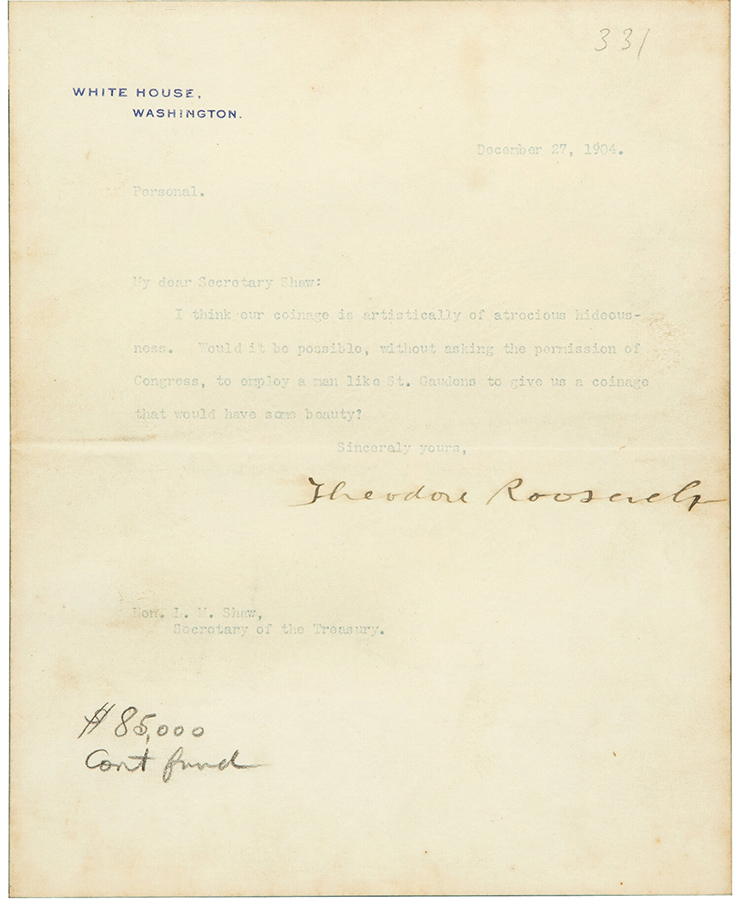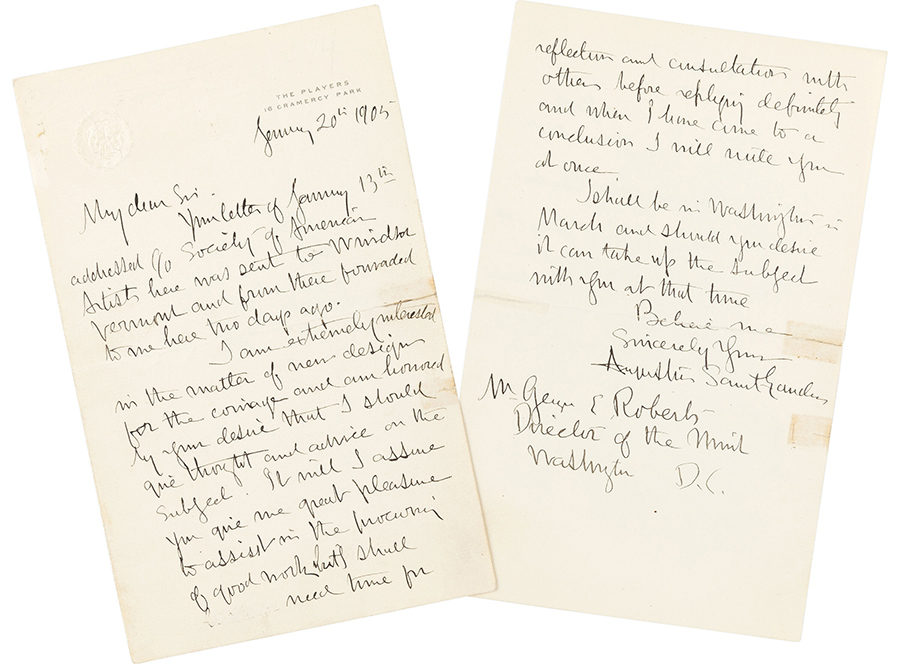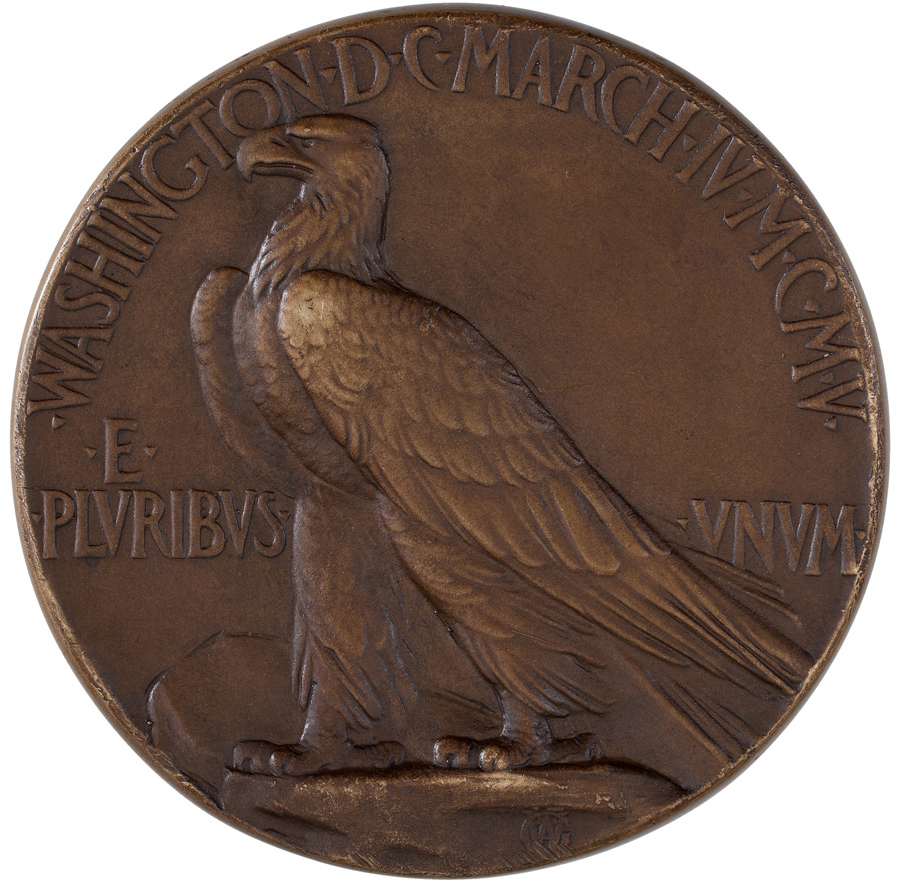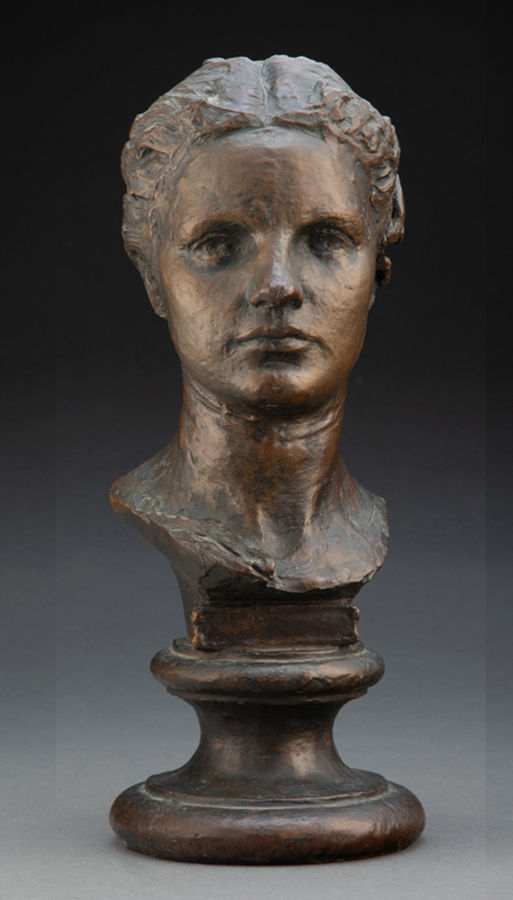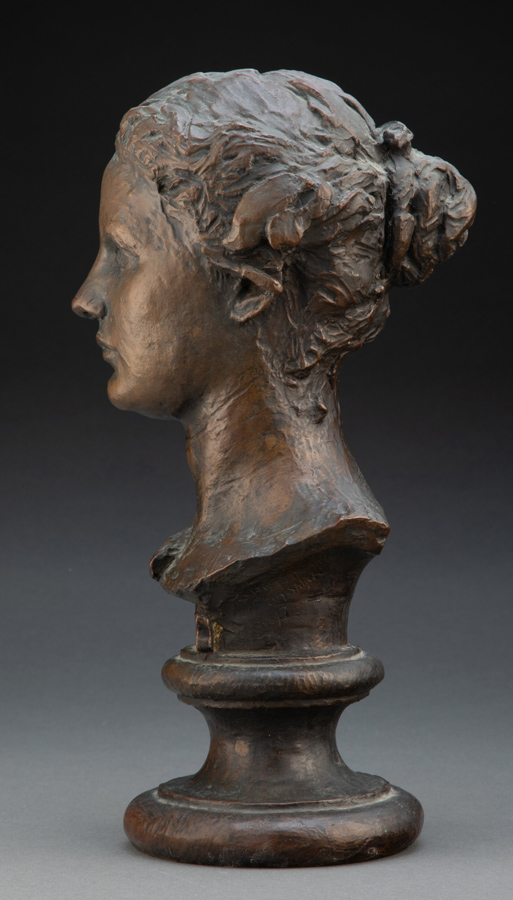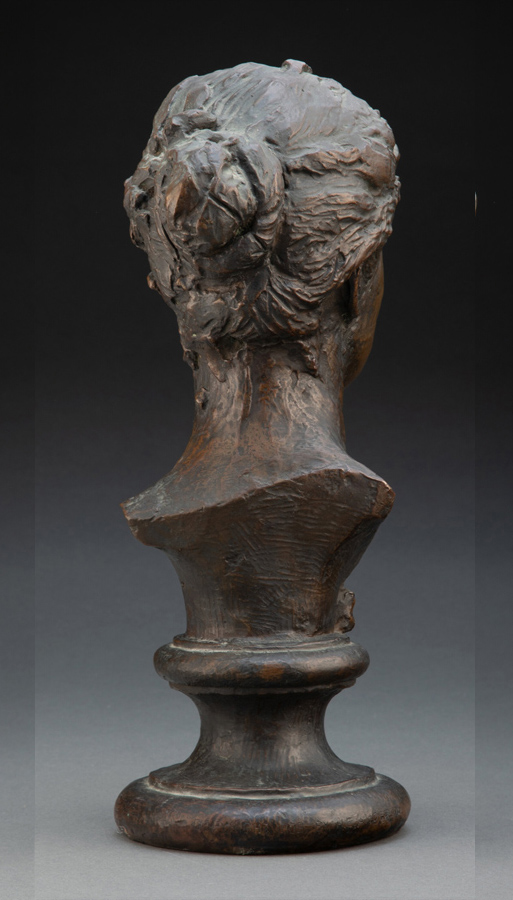A BY-THE-NUMBERS LOOK AT THE DESIGNER BEHIND WHAT MANY CONSIDER THE MOST BEAUTIFUL COIN AMERICA EVER PRODUCED
By Rhonda Reinhart
Take one look at the $20 gold piece Augustus Saint-Gaudens began designing in 1905 at the behest of President Theodore Roosevelt, and it’s easy to see why the creation has been dubbed the most beautiful coin ever minted in the United States. On the obverse, Lady Liberty strides forward, one hand clutching a torch, the other an olive branch. Behind her flowing gown, rays of sun burst forth. On the reverse, an eagle in flight soars in front of similar sun rays.
Though inspired by Greek coins, Saint-Gaudens – one of the eminent sculptors of his time and the first artist unaffiliated with the U.S. Mint to design an American coin – wanted the gold piece to feature symbols representing American icons. He also designed a $10 gold piece featuring Lady Liberty wearing a Native American headdress on the obverse and a standing eagle on the reverse. Saint-Gaudens worked on the coins until his death in 1907. They were cast later that year and produced until 1933, and they remain among the artist’s many lasting legacies.
Below, we look at some of the highlights from Saint-Gaudens’ illustrious career.
Only seven examples of Saint-Gaudens’ 1927-D Double Eagle have been available to the collecting market.
$4,440,000
The record-breaking price paid for a 1927-D Saint-Gaudens Double Eagle in an August 2022 Heritage auction. With only 14 examples traced, the 1927-D $20 is considered a legendary rarity. In fact, in their classic reference Encyclopedia of U.S. Gold Coins: 1795-1933, Jeff Garrett and Ron Guth call it “the rarest regular-issue gold coin of any denomination of the 20th century.” Heritage’s 2022 result for the exceedingly rare coin, which hailed from The Bob R. Simpson Collection, more than doubled the previous record for the 1927-D Double Eagle set at Heritage in January 2020. That the sought-after coin came from Simpson is no surprise; his collection has been ranked by Professional Coin Grading Service (PCGS) as one of the finest ever assembled.
A recasting of Saint-Gaudens’ Robert Gould Shaw sculpture on the grounds of the Saint-Gaudens National Historical Park. Courtesy National Park Service/Don Freeman.
1876
The year Saint-Gaudens received his first major public commission, a monument to Admiral David Glasgow Farragut, the first person to hold the rank of full admiral in the U.S. Navy. The monument was unveiled in Manhattan’s Madison Square Park in 1881. Among Saint-Gaudens’ other public works is Boston’s Robert Gould Shaw and 54th Massachusetts Infantry Regiment Memorial commemorating one of the first Black fighting units to serve in the Civil War. After the monument’s unveiling in 1897, author Henry James had this to say of the bronze sculpture: “How I rejoice that something really fine is to stand there forever for R.G.S. and all the rest of them. This thing of Saint-Gaudens strikes me as real perfection.”
Saint-Gaudens beside ‘The Standing Lincoln’ in 1887. Courtesy National Park Service.
12
The height in feet of Abraham Lincoln: The Man, Saint-Gaudens’ monument to America’s 16th president. Begun in 1885 and dedicated in 1887, the sculpture, also known as “The Standing Lincoln,” resides in Chicago’s Lincoln Park. Over the years, “The Standing Lincoln” was recast many times. Notable examples include the version presented to Great Britain in 1920 and placed in London’s Parliament Square and the version President Lyndon B. Johnson presented to Mexico as a diplomatic gift in 1964. In 2016, another cast of the sculpture was unveiled at the Saint-Gaudens National Historical Park in Cornish, New Hampshire, where the sculptor’s home, studios and gardens are preserved and open to the public.
This original 1904 letter from Theodore Roosevelt to Secretary of the Treasury Shaw realized $94,000 in an August 2012 Heritage auction.
1904
The year President Theodore Roosevelt penned what has become known as the “Genesis Letter,” suggesting that Saint-Gaudens could help beautify America’s coinage. This brief note to Secretary of the Treasury Leslie M. Shaw on December 27 of that year began the process of redesigning the country’s coinage, a process that evolved from 1907 through 1921 and eventually changed the design of all denominations of U.S. coins. In the straightforward language for which the president was known, he wrote: “I think our coinage is artistically of atrocious hideousness. Would it be possible, without asking the permission of Congress, to employ a man like St. Gaudens to give us a coinage that would have some beauty?” The letter kick-started the most creative period in U.S. numismatics, an era that has been termed a renaissance in American coinage.
This autograph letter signed from Saint-Gaudens to the director of the U.S. Mint sold for $106,250 in a July 2022 Heritage auction.
2
The number of pages of the letter Saint-Gaudens wrote to Director of the U.S. Mint George E. Roberts accepting the commission of new designs for several coins, including Saint-Gaudens’ iconic $20 gold piece. In the letter, dated January 20, 1905, the artist writes, in part: “I am extremely interested in the matter of new designs for the coinage and am honored by your desire that I should give thought and advice on the subject.” Saint-Gaudens’ letter was in reply to correspondence sent at the urging of President Roosevelt, who, in 1908, a year after the artist’s death, said in a speech that Saint-Gaudens’ coins were “more beautiful than any coins since the days of the Greeks.”
125
The number of Theodore Roosevelt inaugural medals designed by Saint-Gaudens, modeled by Adolph Weinman and cast in bronze by Tiffany & Co. in 1905. Members of the Inaugural Executive Committee received 82 of the medals, President Roosevelt received 35, Saint-Gaudens got five, and three were given to prominent libraries. The obverse features Roosevelt’s portrait and the Latin phrase Aequum cuique, a loose translation of his campaign slogan, “A square deal for every man.” The reverse portrays an imposing eagle perched on a rocky crag, along with the place and date of the president’s second inauguration. The medal, considered the rarest and most desirable of official presidential inauguration medals, was the first project to emerge from Roosevelt and Saint-Gaudens’ legendary collaboration.
The Saint-Gaudens cast of Victory that resides at The Metropolitan Museum of Art
60
The number of Saint-Gaudens works housed at The Metropolitan Museum of Art in New York City. Among the highlights is a circa 1914 cast adapted from the full-size figure of Victory that stands on the sculptor’s gilded-bronze monument to General William Tecumseh Sherman. Dedicated in 1903 in New York’s Grand Army Plaza, the monument pays homage to one of America’s best-known generals and depicts Victory as a guiding force and allegorical figure of peace. Draped in an eagle-emblazoned gown and donning a crown of laurel, Victory was modeled after Hettie Anderson, a preferred model of Saint-Gaudens and other artists working in Gilded Age New York.
Saint-Gaudens’ bronze bust of model Hettie Anderson, who loaned the work to museums between 1908 and 1911
$200,000
The price paid in a November 2023 Heritage auction for a bronze bust of Hettie Anderson conceived by Saint-Gaudens in 1897. The bust was Saint-Gaudens’ first study for the head of Victory for his General Sherman monument. In 1908, Anderson copyrighted the bust after Saint-Gaudens’ family sought to reproduce it shortly after his death. She refused, writing to the family in response: “…if I were to allow it to be copied it would greatly depreciate its value – innumerable copies could be made of it. In my possession it is the only one and therefore more valuable.” Anderson, who was born into an African American family in South Carolina in 1873, was also Saint-Gaudens’ model for the figure of Liberty on his $10 and $20 gold coins. He once called her the “handsomest model” he had ever seen.
Saint-Gaudens’ 1907 Rolled Rim Indian Eagle is listed in Jeff Garrett and Ron Guth’s ‘100 Greatest U.S. Coins.’
50
The net mintage of the Rolled Rim variant of Saint-Gaudens’ 1907 Indian Eagle. Of all the issues in the Indian eagle series, only the famous 1933 might be more elusive than the 1907 Rolled Rim variant. PCGS CoinFacts estimates the surviving population at 40 to 42 specimens. Two Rolled Rim examples are included in the National Numismatic Collection at the Smithsonian Institution, and two more are in the collection of the American Numismatic Society. In a July 2022 auction, Heritage sold a 1907 $10 Rolled Rim graded MS66 by PCGS for $810,000.
 RHONDA REINHART is editor of Intelligent Collector.
RHONDA REINHART is editor of Intelligent Collector.
